3D printer have become much more accessible and affordable. Among the various types of 3D printers, fused deposition modeling (FDM) is the most popular for desktop use due to its low cost and ease of use. Basic FDM printers start at around $150, while professional-grade models can exceed $5,000. Although fully assembled printers provide immediate, high-quality results, building your own can be a cost-effective and educational project. It allowing you to understand the mechanics and customization potential of these machines.
You can build a 3D printer using two main methods: from a kit or from scratch. For the second way, you can learn from this article : How to 3D Print a 3D Printer?. Whether you're a DIY enthusiast or a curious beginner, this guide will help you get started on your journey to creating a custom 3D printer.
This article main focus on how to build 3D printers by yourself from 3D printer kits. Here are some of the best DIY 3D printer kits available, ensuring you get hands-on experience with the latest technology and most reliable designs.
Voron 2.4
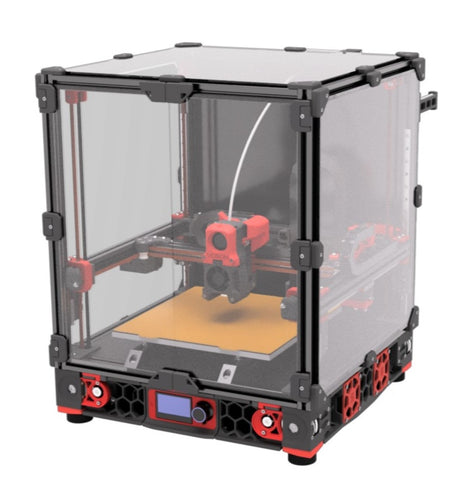
Description: The Voron 2.4 is a high-end DIY 3D printer kit known for its robust construction and exceptional print quality. It features a fully enclosed design, which helps maintain a stable temperature environment for better print consistency. This printer is highly customizable, allowing enthusiasts to tailor it to their specific needs.
Key Features:
● Print Area: 300 x 300 x 300 mm
● Materials: Supports a wide range of filaments including PLA, ABS, PETG, TPU, Nylon, and more.
● Hotend Temperature: Up to 300°C, allowing for high-temperature materials.
● Print Bed Temperature: Heated bed up to 120°C, ideal for various filament types.
● Frame: All-metal frame, ensuring durability and stability; uses high-quality aluminum extrusions and steel components for rigidity and precision.
● Cooling: High-quality cooling system to minimize warping; includes dual cooling fans for efficient heat dissipation.
● Electronics: Uses high-end components for reliable performance.
○ Controller Board: Typically uses a Duet 3 or a SKR 1.4 for advanced features and expandability.
○ Drivers: Silent stepper motor drivers like TMC2209 for quieter and smoother operation.
○ Sensors: Required for cape and arms; tree supports for resin
○ Display: Required for cape and arms; tree supports for resin
● Waste Management: Effective waste management with minimal filament waste due to precise extrusion control.
HyperCube Evolution
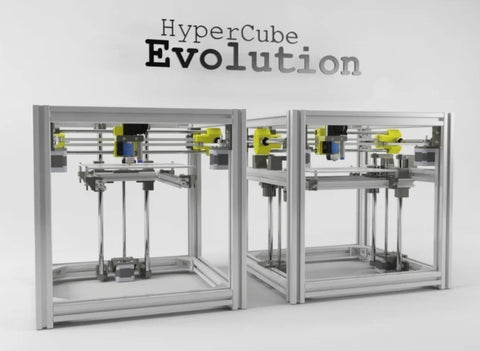
Description: The HyperCube Evolution is an open-source 3D printer design known for its simplicity and efficiency. It employs a core-XY motion system that enhances print speed and accuracy. The modular design allows for easy upgrades and modifications.
Key Features:
● Print Area: 300 x 300 x 300 mm
● Materials: Compatible with PLA, ABS, PETG, TPU, Nylon, and more.
● Hotend Temperature: Up to 280°C, suitable for most standard and high-temp filaments.
● Print Bed Temperature: Heated bed up to 110°C, supporting a variety of materials.
● Frame: Aluminum extrusion frame for sturdy build; designed with precision-cut extrusions and corner brackets for increased rigidity.
● Cooling: Effective part cooling fans to improve print quality; includes multiple fans for optimal cooling.
● Electronics: Customizable electronics with support for various boards.
○ Controller Board: Compatible with popular boards like the RAMPS 1.4 or Duet WiFi for flexibility.
○ Drivers: Options to use silent drivers like TMC2130 for noise reduction.
○ Sensors: Option to add auto bed leveling sensors.
○ Display: LCD screen with knob control or touchscreen for user-friendly interface.
● Waste Management: Efficient filament usage with minimal waste.
Prusa i3 MK3S+ (DIY Kit)
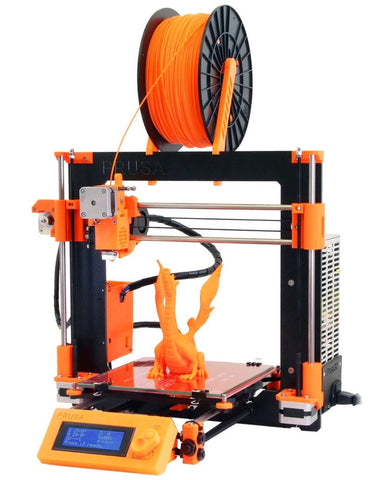
Description: The Prusa i3 MK3S+ is a well-known DIY kit from Prusa Research. It is celebrated for its reliability, quality, and community support. The MK3S+ features several advanced functionalities, making it suitable for both beginners and experienced makers.
Key Features:
● Print Area: 250 x 210 x 210 mm
● Materials: Wide compatibility with PLA, ABS, PETG, ASA, Nylon, and more.
● Hotend Temperature: Up to 300°C, allowing for a broad range of filaments.
● Print Bed Temperature: Heated bed up to 120°C, perfect for various materials.
● Frame: Sturdy aluminum and steel frame; designed with a combination of laser-cut aluminum and steel sheets for maximum durability.
● Cooling: Efficient cooling system with dual fans; includes a nozzle fan and a part cooling fan for better print results.
● Electronics: Equipped with Prusa's custom electronics for enhanced performance.
○ Controller Board: Prusa's custom EINSY RAMBo board for precise control and reliability.
○ Drivers: Integrated Trinamic drivers for quiet and smooth operation.
○ Sensors: Filament sensor, power panic, and crash detection for improved print reliability.
○ Display: Minimal waste with precise filament sensor and recovery features.
● Waste Management: Efficient filament usage with minimal waste.
Rat Rig V-Core 3
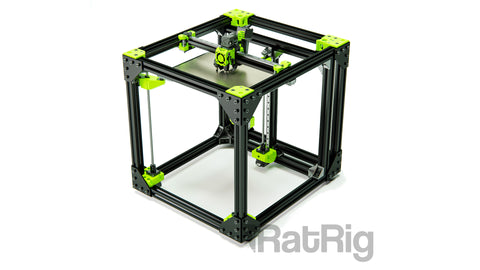
Description: The Rat Rig V-Core 3 is a versatile and high-performance DIY 3D printer kit. It offers a robust core-XY design, providing both speed and accuracy. The V-Core 3 is highly customizable, making it a favorite among enthusiasts looking for a reliable and adaptable printer.
Key Features:
● Print Area: 400 x 400 x 400 mm
● Materials: Supports PLA, ABS, PETG, TPU, Nylon, and more.
● Hotend Temperature: Up to 300°C, suitable for high-temperature filaments.
● Print Bed Temperature: Heated bed up to 120°C, accommodating a variety of filaments.
● Frame: Durable aluminum extrusion frame; built with industrial-grade extrusions and reinforced joints for added stability.
● Cooling: Advanced cooling system to maintain print quality; features multiple fans for efficient heat management.
● Electronics: Open-source electronics, compatible with various controllers
○ Controller Board: Often uses Duet 2 WiFi or SKR 1.4 for comprehensive control features.
○ Drivers: TMC2209 drivers for quiet and efficient motor control.
○ Sensors: Bed leveling and filament runout sensors.
○ Display: Color touchscreen interface for easy operation.
● Waste Management: Low waste due to efficient filament use and control.
Creality CR-10 (DIY Kit)
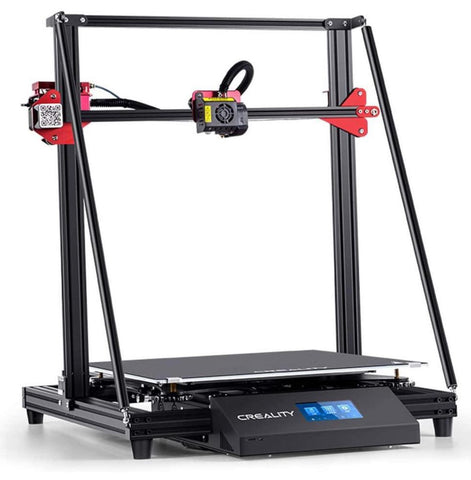
Description: The Creality CR-10 is a popular DIY 3D printer known for its large build volume and ease of assembly. It is an excellent choice for hobbyists and professionals looking for a cost-effective, high-quality printer.
Key Features:
● Print Area: 300 x 300 x 400 mm
● Materials: Compatible with PLA, ABS, PETG, TPU, and more.
● Hotend Temperature: Up to 250°C, suitable for standard filaments.
● Print Bed Temperature: Heated bed up to 100°C, adequate for most materials.
● Frame: Sturdy aluminum frame; designed with a stable base and precision-cut aluminum for reliable performance.
● Cooling: Effective cooling system for better prints; includes dual fans for optimal cooling.
● Electronics: User-friendly electronics with easy setup
○ Controller Board: Equipped with a basic but reliable board like the Creality V2.1.
○ Drivers: Standard A4988 stepper drivers.
○ Sensors: Option to add a BLTouch for automatic bed leveling.
○ Display: Basic LCD screen with rotary knob.
● Waste Management: Minimal filament waste due to precise extrusion.
VzBot 3D Printer
Description: The VzBot 3D Printer is a recent addition to the DIY 3D printer market, known for its robust design and excellent print quality. It features a core-XY motion system, providing both speed and precision. The VzBot is designed for easy assembly and customization.
Key Features:
● Print Area: 300 x 300 x 300 mm
● Materials: Supports PLA, ABS, PETG, TPU, Nylon, and more.
● Hotend Temperature: Up to 300°C, suitable for high-temperature materials.
● Print Bed Temperature: Heated bed up to 120°C, supporting various filament types.
● Frame: Aluminum extrusion frame for added durability; designed with high-quality extrusions and reinforced connections for stability.
● Cooling: High-performance cooling system to ensure consistent print quality; features dual fans for effective heat management.
● Electronics: Open-source electronics with support for various controllers
○ Controller Board: Commonly uses Duet 3 or SKR 1.4 for extensive features.
○ Drivers: TMC2209 for silent and precise motor control.
○ Sensors: Filament detection and bed leveling sensors.
○ Display: Touchscreen interface for user-friendly control.
● Waste Management: Efficient filament usage with minimal waste.
Tronxy X5SA Pro
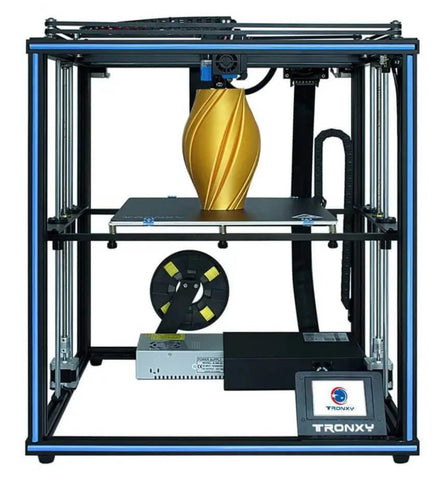
Description: The Tronxy X5SA Pro is an affordable DIY 3D printer kit that offers a large build volume and a sturdy frame. It is ideal for users looking for a balance of cost and functionality, with easy assembly and reliable performance.
Key Features:
● Print Area: 330 x 330 x 400 mm
● Materials: Compatible with PLA, ABS, PETG, TPU, and more.
● Hotend Temperature: Up to 275°C, allowing for a variety of filaments.
● Print Bed Temperature: Heated bed up to 100°C, supporting most standard materials.
● Frame: Sturdy aluminum frame; designed with reinforced corners and metal brackets for increased stability.
● Cooling: Efficient cooling system with dual fans; includes part cooling and extruder cooling for optimal performance.
● Electronics: Reliable and user-friendly electronics
○ Controller Board: Equipped with the MKS Gen L board for easy upgrades and customization.
○ Drivers: Silent stepper drivers for quiet operation.
○ Sensors: Auto bed leveling sensor and filament runout detection.
○ Display: Large LCD screen with intuitive controls.
● Waste Management: Designed to minimize filament waste with precise extrusion control.
BLV MGN Cube
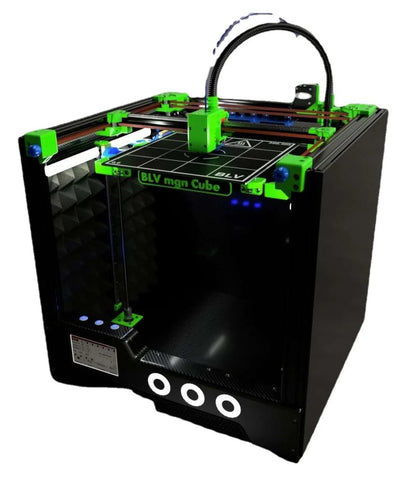
Description: The BLV MGN Cube is a versatile and high-performance DIY 3D printer kit that uses a core-XY motion system. It is highly customizable, making it an excellent choice for advanced users who want to fine-tune their machine for specific needs.
Key Features:
● Print Area: 300 x 300 x 300 mm
● Materials: Supports PLA, ABS, PETG, TPU, Nylon, and more.
● Hotend Temperature: Up to 300°C, suitable for high-temperature materials.
● Print Bed Temperature: Heated bed up to 120°C, ideal for a range of filaments.
● Frame: Robust aluminum extrusion frame; designed with high-precision extrusions and solid joints for maximum stability.
● Cooling: Advanced cooling system with multiple fans; ensures consistent cooling for high-quality prints.
● Electronics: Flexible electronics with support for various configurations
○ Controller Board: Often uses Duet 3 or SKR 1.4 for advanced control features.
○ Drivers: TMC2209 drivers for silent and smooth operation.
○ Sensors: Auto bed leveling and filament runout sensors.
○ Display: Touchscreen interface for easy operation and monitoring.
● Waste Management: Efficient filament usage with minimal waste.
HevORT
Description: The HevORT is a high-performance DIY 3D printer known for its speed and accuracy. It features a core-XY motion system and a rigid frame, making it ideal for producing high-quality prints quickly.
Key Features:
● Print Area: 300 x 300 x 300 mm
● Materials: Supports PLA, ABS, PETG, TPU, Nylon, and more.
● Hotend Temperature: Up to 300°C, suitable for high-temperature materials.
● Print Bed Temperature: Heated bed up to 120°C, ideal for a range of filaments.
● Frame: Robust aluminum extrusion frame; designed with high-precision extrusions and solid joints for maximum stability.
● Cooling: Advanced cooling system with multiple fans; ensures consistent cooling for high-quality prints.
● Electronics: Flexible electronics with support for various configurations
○ Controller Board: Often uses Duet 3 or SKR 1.4 for advanced control features.
○ Drivers: TMC2209 drivers for silent and smooth operation.
○ Sensors: Filament detection and auto bed leveling sensors.
○ Display: Full-color touchscreen interface for user-friendly control.
● Waste Management: Minimal filament waste due to precise extrusion and efficient filament management.
RailCore II 300ZL
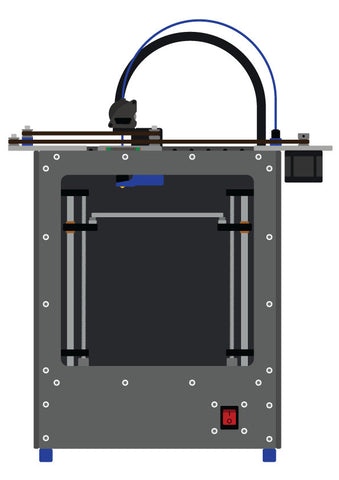
Description: The RailCore II 300ZL is a high-precision DIY 3D printer kit known for its rigidity and accuracy. It uses a core-XY motion system and offers a robust design, making it suitable for professional-grade prints.
Key Features:
● Print Area: 300 x 300 x 600 mm
● Materials: Supports PLA, ABS, PETG, TPU, Nylon, and more.
● Hotend Temperature: Up to 300°C, ideal for high-temperature materials.
● Print Bed Temperature: Heated bed up to 120°C, suitable for various filament types.
● Frame: High-strength aluminum extrusion frame; built with precision-cut extrusions and reinforced connections for maximum stability and accuracy.
● Cooling: Advanced cooling system with dual fans; ensures efficient cooling for consistent print quality.
● Electronics: High-end electronics for reliable and precise control
○ Controller Board: Often uses the Duet 3 for advanced features and flexibility.
○ Drivers: Silent stepper drivers like TMC2209 for quiet and smooth operation.
○ Sensors: Auto bed leveling and filament runout sensors.
○ Display: Full-color touchscreen interface for easy control and monitoring.
● Waste Management: Efficient filament usage with minimal waste due to precise extrusion control.
FAQ
Can you make a DIY 3D printer?
Yes, you can build a DIY 3D printer using available kits and open-source designs. These kits provide the necessary components and detailed instructions to assemble your printer from scratch. Building your own 3D printer can be a rewarding experience, offering the opportunity to learn about the mechanics and electronics involved. It also allows for customization and upgrades, enabling you to tailor the printer to your specific needs. Popular DIY kits often come from well-known brands, ensuring quality and support. With patience and some technical know-how, you can successfully build a functional and efficient 3D printer.
Is there anything illegal to 3D print?
While 3D printing technology itself is legal, using it to create certain items can be illegal. Manufacturing firearms, counterfeit goods, or copying copyrighted materials without permission can lead to legal consequences. The legality of 3D printed objects is governed by local, national, and international laws, which can vary. It is crucial to ensure your 3D printing activities comply with relevant regulations to avoid legal issues. Always stay informed about the laws in your area and consult legal advice if you are uncertain about the legality of a particular 3D printed object.
Can you make a 3D print of yourself?
Yes, you can make a 3D print of yourself using 3D scanning technology. The process involves capturing your likeness with a 3D scanner, which creates a digital model of your body or face. This model can then be printed using a 3D printer. Various services and tools are available to assist with both the scanning and printing phases. Some services offer professional-grade scans for highly detailed models, while others provide more accessible options for home use. The resulting 3D print can be used for personalized figurines, sculptures, or ergonomic designs.
What materials do you need to make a 3D printer?
To build a DIY 3D printer, you will need materials such as aluminum extrusions or steel for the frame, stepper motors for movement, belts and pulleys for mechanical motion, a hotend for melting the filament, and a heated bed for proper adhesion of prints. You will also need electronic components like a controller board, drivers, sensors, cooling fans, and a power supply. Detailed instructions and parts lists are usually provided with DIY kits, making it easier to gather all the necessary components. With these materials, you can assemble a reliable and efficient 3D printer tailored to your specifications.





